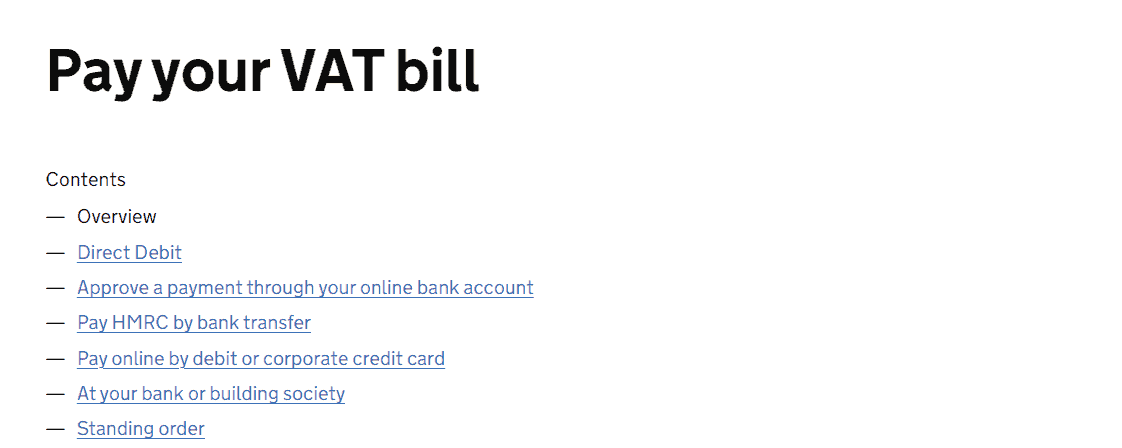Wondering how you can make your VAT payments in the UK? Then this guide is for you.
What Is VAT?
VAT (Value Added Tax) is the amount a VAT-registered business must add to its products. This money does not go towards the business’s profits – it goes to HMRC.
You become a VAT-registered business when your taxable turnover exceeds £85,000. Alternatively, you can become a voluntary VAT business if your taxable turnover is under £83,000.
There are several benefits to being a VAT business, including the fact you can reclaim VAT included in items you buy.
How often do I need to pay VAT to HMRC?
You can pay your VAT bill either monthly or quarterly.
If you pay for your bill monthly or quarterly, you’ll have to pay your VAT bill one month plus seven days after the end of your last VAT period.
Alternatively, you can pay your VAT bill through the Annual Accounting Scheme. This allows you to pay for VAT in a single payment per year and is recommended for small businesses.
VAT Payment Methods

The first thing you have to do is file your VAT return through MTD-compliant software. This VAT return form tells HMRC how much you’ve paid and the amount you’ve earned in VAT.
You’ll then be given a deadline by which you need to settle the amount.
There are six main payment methods for paying VAT. They include:
CHAPS
If your bank supports CHAPS (Clearing House Automated Payment System), you can pay your VAT bill this way. If you make the CHAPS payment before 2 pm, HMRC will receive your VAT payment on the same day. CHAPS is the most secure way to make your VAT payment.
The only downside to this payment method is the clearance fees. These are typically approximately £30; this option would only be worthwhile if you’re submitting a large amount.
To make the payment, you’ll need your company’s VAT registration certificate. This will contain your 9-digit VAT registration number. You’ll also need the HMRC sort code, account number, and account name.
Online or telephone banking
This is another same-day (or, at least next-day) method of paying VAT. You can pay HMRC the same way you would make any online payment or telephonically.
To pay VAT online, you’ll need your company’s registration number and HMRC’s bank account details.
BACS
BACS (Bacs Payment Schemes Limited) allows you to make a bank transfer either through a debit or credit card. It takes roughly three days to complete a BACS payment. You must first sign up for BACS and wait to receive your Service User Number.
After you’ve submitted the bill, BACS requires some time to process it.
As with CHAPS and telephone or online banking, you need your registration number and HMRC’s details.
Direct debit
It’s possible to set up a direct debit to take care of your VAT bill. This can be done for no charge on your HMRC VAT online account. Money will be automatically lifted from your account three working days after your bill’s due date.
Make sure you set up your first direct debit payment at least three days prior to the deadline. This way, you can ensure that the VAT bill is paid timeously.
Standing order
You can make your VAT payments through a standing order if you’re using the Accounting Scheme mentioned above. For this to work, you must gain approval from HMRC upon applying for the scheme. You also have to have a fixed bill, rather than a variable one. This can be set up via your online bank account or via telephone banking.
After paying VAT online, you need to check your VAT online account on HMRC to ensure that the payment has been received.
How To Pay VAT In Person
If you don’t want to pay VAT online, you can order payment slips from HMRC. You can then make the payment at a bank or building society.
Final Thoughts
You can pay your VAT bill online through a direct debit or a standing order. Other options are to settle the bill via CHAPS, BACS, or through online or telephone banking.
It’s always advised to employ an accountant to manage your VAT account and pay the VAT bill on time.
Sources:
https://www.xero.com/uk/guides/paying-vat-online/
https://www.freshbooks.com/en-gb/hub/taxes/how-to-pay-vat-bill-online
https://wise.com/gb/blog/how-to-pay-vat-online-the-ultimate-guide
https://ember.co/content/article/how-to-pay-your-uk-vat-bill